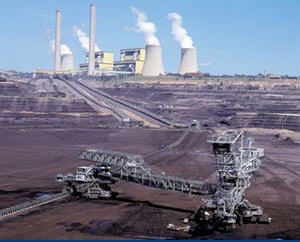Leading Australian utility AGL Energy has called for the country to implement an “ambitious” carbon budget that reflects the goal of limiting global warming to a maximum 2C.
In a submission to the Climate Change Authority’s review on emission caps and target, AGL Energy urges the CCA not to be conservative in setting such a carbon budget, and says it should not be conditional on the actions of other countries.
This appears to be a criticism of the bipartisan policy positions held by the Labor government and the Coalition favoured to take power in the upcoming September poll. Both parties have a policy of low binding targets (currently 5 per cent below 1990 levels by 2020), while making more ambitious targets (15 to 25 per cent) conditional on actions elsewhere.
AGL says this could be counter-productive because Australia’s has among the highest per capita levels of emissions in the world, and carries significant economic risks because of it.
“While the achievement of global climate change goals by definition requires global action, AGL would discourage too much dependency or conditionality between Australia’s climate change goals and those of other countries,” it says.
“Australia’s carbon dioxide emissions per unit of GDP are considerably higher than other comparable countries. Accordingly, Australia is facing greater economic risks as a result of global action to reduce emissions.”
The call for a carbon budget – rather than just a series of short term emission caps and targets – echoes similar positions adopted by the CCA itself, environmental groups, think tanks and academics, but it is believed the first time the concept of a carbon budget, let alone a tight one, has been recommended by a major emitter.
AGL holds the largest portfolio of renewable energy producers in the country, including a half share in the recently completed 420MW Macarthur wind farm, the largest in the country. And it owns hydro-electric stations and peaking gas plants. But it also owns Australia’s largest single emitter, the 2,200MW Loy Yang A brown coal power station in Victoria, which it took full ownership of last year.
In its submission, AGL says there is broad agreement that a global carbon budget could be the most effective way of meeting climate goals, which are to limit average warming to no more than 2 degrees Celsius as compared with pre-industrial temperatures.
“This global climate objective is able to be converted with a reasonable degree of accuracy to the total volume of global emissions that can occur in order to have a reasonably high probability of achieving this objective,” it writes.
“Long term budgets provide clearer investment signals to guide financing decisions in high emitting industries with long investment timeframes.”
There is widespread agreement among agencies as to the size of the global carbon budget, which is variously put at around 700 billion tonnes, depending on whether the world wants to aim for an 80 per cent chance of avoiding dangerous climate change or a 50 per cent. The budget further contracts if the target becomes 1.5C.
However, the contribution of individual countries to that budget is more controversial. The Climate Institute last month suggested it could be within 8 and 15 billion tonnes, depending on how it is measured, which could be by using per capita emissions, historical output, GDP and ability to pay, the profile of the economies, and what like-for like countries – be they defined as trade competitors, on standing of living, or resources – are doing.
TCI deputy CEO Erwin Jackson said at the time: “If the average Australian consumes no more of the global budget than the average person in other advanced economies then over the next 40 years we can only release 8 billion tonnes (of) carbon pollution. At current emission levels this budget would be consumed in around 15 years.”
He said that would result in a dramatic transformation of Australia’s electricity industry, suggesting the closure of coal-fired generators. AGL, however, is confident that Loy Yang A can be “one of the last standing” because of its relative youth and efficiency levels, and its lower levels of debt.
AGL, for its part, does not nominate a budget but says the CCA should adopt a “robust, ambitious, and flexible long term climate change mitigation measures” which are then translated into clear, consistent, short term targets.
“Decisive and orderly policy and investment in the short- term can prevent the need for dramatic and overly costly policy and investment later,” it writes.
The CCA has called for submissions by the end of the month into its review. A draft is due in October with a final report to be delivered next year. It is not yet clear that it will be able to deliver this document because the Coalition has vowed to dissolve the CCA should it win power in September’s poll.










